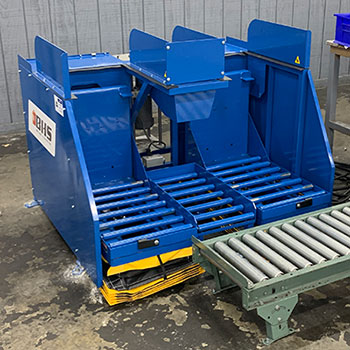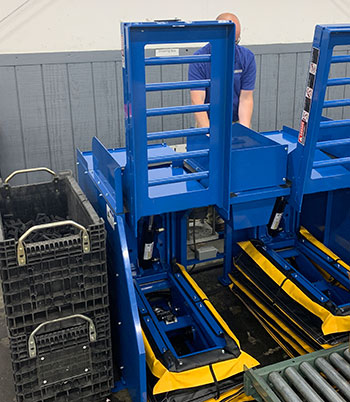We use cookies to make your experience better. To comply with the new e-Privacy directive, we need to ask for your consent to set the cookies. Learn more.
BHS Case Study: BHS, Inc. Improves Manufacturing Efficiency with Assembly Work Stations
Over four decades, BHS, Inc. has built a reputation for industry-leading material handling equipment. But what really sets the St. Louis-based manufacturer apart is its ability to create custom material handling systems, from the design table through on-site integration.
“It’s not just standardized products that we can make, and we don’t want to just be a standard manufacturer because there’s a million of them out there,” said Trent Boothe, the BHS Project Manager who oversaw the projects we discuss below. “We are the company that will manufacture equipment to fit your exact application.”
Camp Jennings, Sales Manager at Carolina Handling in Birmingham, Alabama, is an early supporter of BHS’ role as material handling integrator. The forklift dealer maintains an account with Connector Manufacturing Company, Greenville, Alabama-based maker of utility and OEM components that’s been in business since the early 1940s.
When Connector Manufacturing’s needs progressed beyond forklifts and into broader material handling systems, Jennings thought of BHS, Inc. All three companies — manufacturer, dealer, and end user — would end up working together on two custom material handling solutions, with BHS acting as lead integrator on each project. We discuss the first here.
The Problem: Assembly Ergonomics and Efficiency
Connector Manufacturing was interested in boosting productivity wherever they could. More importantly, they wanted to eliminate the possibility of ergonomic injury among their staff. These goals started on the assembly floor. Employees manually assembled some components, but feeding the line always seemed to slow them down, and could create ergonomic risks.
Connector Manufacturing had experimented with different line-feeding techniques, but company leadership wasn’t satisfied. The problem remained: Containers of unassembled components simply weighed too much to ask workers to lift them. When the components arrived on the assembly floor, workers had to travel to them, grab handfuls, take them back to their assembly desks, and repeat this multi-step action many times during a shift.
“These totes that come in with the parts can weigh upwards of 200 pounds,” Boothe said. “There’s no way they’re picking that up. So they were hand-picking every component.”
The challenges on the assembly side were to give workers access to components safely and efficiently, to reduce the strain of repetitive motions, and to boost production on assembly and transfer of assembled parts.
Expert Analysis from BHS
The trouble on the assembly floor was essentially a lack of ergonomic assistance. The Occupational Safety and Health Administration (OSHA) defines ergonomics as “fitting a job to a person.” When work systems adapt to workers’ bodies, and not the other way around, users are able to improve productivity and reduce injury risk at once.
This assessment led the BHS engineering team to the International Standard document ISO 11228-3: Ergonomics — Material Handling — Part 3: Handling of low loads at high frequency. This standard instructs users to limit forceful exertion, avoid static and awkward postures, and prevent extreme ranges of movement, such as reaching and stretching.
What Connector Manufacturing needed, then, was a work station designed for worker comfort. It had to give employees immediate access to components without having to cross the floor, and it had to keep that access static even as the level of contents in the bins sank over time. Finally, the system would have to include a simple collection mechanism for completed products — and the work station would have to do all this without requiring the worker to reach, stretch, or leave their post.
Alternate feeding configurations had not solved these complex problems, despite Connector Manufacturing’s experiments.
“They tried some systems that would store components overhead in a container, and then funnel them down when needed,” Boothe said. “But that never really worked out well.”
Connector Manufacturing needed a new approach. Meeting all these goals in a single unit would require the integration of multiple products into a new, custom solution.
The Solution: The BHS Assembly Work Station

The Assembly Work Station integrates a desk with two tilt tables to keep the job's materials close at hand. Assembled components get dropped through the middle of the table for collection and transfer down the line.
The final product was dubbed the BHS Assembly Work Station, a model of material handling integration. It incorporates two Tilt Tables into a cutaway steel desk, complete with vinyl trim for safety and comfort. A steel, powder-coated chute in the center of the Work Station collects completed products in bins for transfer to the packing line.
“It’s a Work Station where employees, they take two bins full of, say, a ground-lug and a set-screw,” Boothe said. “This table tilts these totes up to where access is much more ergonomic. So the worker sitting at the desk can stay seated. She funnels some parts out onto her desk, and she has a giant industrial screwdriver in the center. And she assembles the parts, throws them down an opening in the middle, and there’s your assembled part.”
The Assembly Work Station completely eliminated trips to the bulk bins by placing those bins within the table itself. It also reduced the risk of musculoskeletal injury by providing easy access to parts through hydraulic Tilt Tables.
Implementation of Assembly Work Stations

Trent Boothe tests the 90° tilt function of both Tilt Tables in tandem.
After a few months of working with the original Assembly Work Station, Connector Manufacturing, in partnership with Carolina Handling, compiled a list of feedback and design tweaks. The BHS team took this list and incorporated it into a second-generation model. Both the original and the new design are currently in use at the manufacturing facility.
Results of Assembly Work Station Installations
As of this writing, the first Assembly Work Station has been in place for about two years. The second, redesigned model has been in place for a few months.
In that time, Connector Manufacturing management has noticed remarkable safety and productivity benefits. Content with the final design of this custom model, Carolina Handling is working with BHS to provide 14 additional Assembly Work Stations for Connector Manufacturing in the coming weeks and months.
Perhaps more telling, both the dealer and the end-user were impressed with BHS’ products and integration services, enough so to call BHS, Inc. in on another custom solution. Learn more about that project in our case study titled “Following the Success of Custom Assembly Tables, BHS, Inc. Returns with Packing Solutions.”
Interested in working with BHS?
Contact sales@bhs1.com or 1.800.BHS.9500 to discuss your opportunity.

